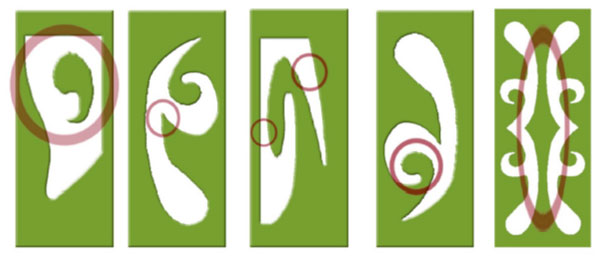Pattern Mapping for Lasting Design
Creating Patterns with Structural Integrity
Sometimes a designer will want to apply their artistic talents toward customizing a panel with their own unique pattern. Today, manufacturing processes have advanced to such a degree that custom panels can be designed with almost any imaginable pattern and custom brackets make it possible to affix these custom panels into the built environment in almost any conceivable way.

Image courtesy of Parasoleil
Stencils, sharps, sags, snags, and strips are elements to avoid in any design to ensure the structural integrity and safety of the architectural panel.
While it may be possible to have any pattern physically machined into a panel, there are a few design elements that should be avoided to keep the panels safe, functional, and structurally sound in the environment. One of the challenges in creating a panel design is that the design must be considered both in terms of what is being cut out and the structure that remains. General design guidelines for these panel products identify stencils, sharps, sags, snags, and strips as elements to avoid in any custom pattern design.
Avoid Stencils
A stencil refers to an element in a pattern that exists entirely free from the greater surrounding pattern. On paper, depending upon the complexity of the design, it may not be immediately obvious that parts of the pattern are not attached to the structure. In the real-world translation of this design, the stencil will not remain in place on the panel, because nothing is holding it there.
Avoid Sharps
Safety is always a key concern when creating any type of architectural structure. Avoiding sharp and potentially piercing elements on an architectural panel requires that attention be paid to the severity of the angles used in a pattern. While the pieces that are cut-out and removed from the structure can be pointed, the material left behind in the panel cannot be angled sharper than 100 degrees.
Avoid Sags
The base material of the panel needs to be supported at several structural points. The minimum support necessary for most materials is three attachments at 120 degrees, similar to the structure of a three-legged stool. Sags in a pattern occur when sufficient support is not provided to anchor the base material in place and these unsecured elements of the pattern succumb to gravity.
Avoid Snags
Sharp turns in a design can result in catching clothing, purses, pine needles, and other debris. Avoid these areas of entrapment to keep the panel surface litter and debris free.
Avoid Strips
There is a certain proportion between the width and length of material strips that should generally be maintained to ensure that strips in a pattern do not create an area of weakness on the panel, without providing additional support or webbing to the element. Strips measuring 1 to 3 inches in width should not exceed 6 inches in length. Strips that are 5 to 8 inches wide should not exceed a length of 14 inches. Please note that this does not apply to strips of open space.
Testing Structural Integrity
Architectural panels with patterned openings are not merely decorative additions to a space, they are structural installments and, as such, the structural integrity of the patterned panel should be carefully evaluated. Appropriate tests depend upon the exact application and location of the panel. A panel may need to be able to withstand wind loads, snow loads, and college kids climbing on it. Finite Element Analysis (FEA) calculations should be reviewed for any panel before it is specified and, in instances where conditions may be extreme, field testing should be considered.
Patterned panels have long been an aesthetic staple used to enhance the beauty of various architectural elements. A new discourse on the characteristics of patterns and an evaluation of how patterns impact the visual space enable designers to consider the patterned panel as a functional tool that provides privacy, camouflage, shade, and partitioning. This new information can empower the design community to see and use patterns in a new way.
| Parasoleil manufactures a line of elegant, structurally tested panel systems in aluminum with award-winning Patina Powdercoats. Parasoleil patterns filter light in overhead shade applications, frame space with privacy screens and railings, and reduce the heat gain on a building as off-set cladding, light shelves. Panels are also used to hide equipment areas, identify neighborhoods, and as public art installations. www.Parasoleil.com | |









